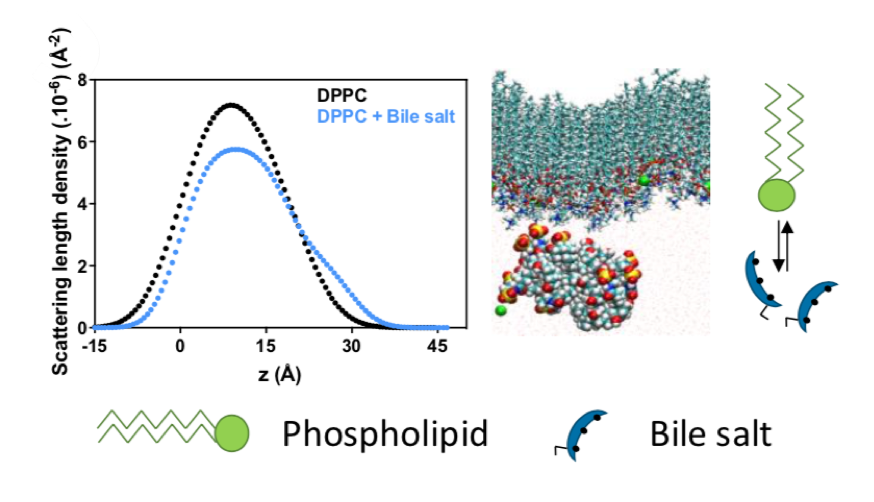Our latest manuscript entitled “Molecular insights into the behaviour of bile salts at interfaces: a key to their role in lipid digestion” features work that we have done in collaboration with the groups of Cécile Dreiss (Institute of Pharmaceutical Science, KCL), Richard Harvey (Institut für Pharmazie, Martin Luther Universität Halle-Wittenberg), Peter J. Wilde (Quadram Institute Bioscience, Norwich), Myriam Grundy (School of Agriculture, Policy & Development, University of Reading) & Isabelle Grillo and Yuri Gerelli (ILL, Grenoble). In this manuscript, we used molecular dynamics simulations to provide an atomistic scale description of the interaction of two types of bile salts (sodium taurocholate (NaTC) & sodium taurodeoxycholate (NaTDC)) with 1,2-dipalmitoyl-sn-glycero-3-phosphocholine (DPPC) monolayers. Our simulations were used to support the experimental work done by Olivia Pabois, who is a very talented PhD student working with Cécile Dreiss and Isabelle Grillo & Yuri Gerelli. 
Bile salts (BS) are biological surfactants that are produced in the liver and stored in the gall bladder. BS play key roles in promoting lipid digestion and absorption. Due to their chemical structure, they display an unusual planar polarity that allows them to adsorb to interfaces of lipid (fat) droplets, where they facilitate the adsorption of the co-lipase-dependent pancreatic lipase onto a BS-dominated surface. Additionally, BS prevent lipase inhibition caused by the accumulation of hydrolysis products by removing polar lipids from the fat droplet surface, solubilising them into mixed micelles. Therefore, in summary, BS play two very different roles in fat digestion: (i) they promote enzyme-catalysed lipolysis by facilitating the adsorption of the lipase/co-lipase complex at the lipid/water interface; meanwhile (ii) they desorb insoluble lipolysis products from the interface, shuttling them into mixed micelles to the gut mucosa, where they are absorbed.
While the contrasting functionalities of BS have been known for some time, their origin is not well understood. This work reports a detailed investigation of the interfacial properties of NaTC and NaTDC, using a range of complementary techniques. As a result, this study provides a molecular-level characterisation of the interfacial films, using neutron reflectometry (NR) combined with molecular dynamics (MD) simulations, bringing an unprecedented insight into the different roles played by BS during lipid digestion.
Full reference: “Molecular insights into the behaviour of bile salts at interfaces: a key to their role in lipid digestion“, Olivia Pabois, Christian D. Lorenz, Richard D. Harvey, Isabelle Grillo, Myriam M.-L. Grundy, Peter J. Wilde, Yuri Gerelli & Cécile A. Dreiss. Journal of Colloid and Interface Science (2019) 556, 266-277.
